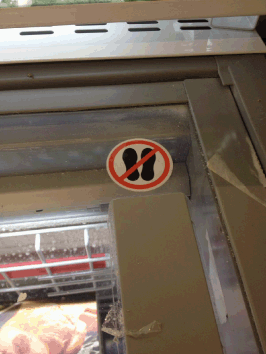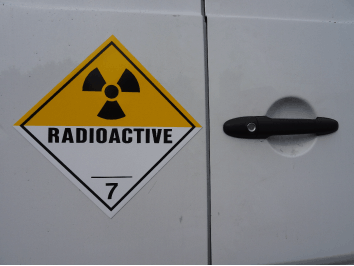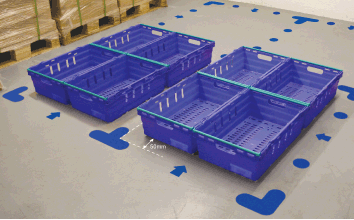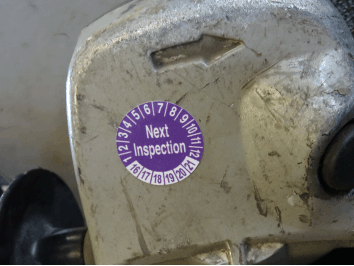Recently a new range of mandatory and prohibition safety symbol labels have been added to our safety label ranges.

These are available in three sizes (50mm diameter, 75mm diameter and 100mm diameter) and are supplied in pack sizes of 25 labels. These self adhesive labels are manufactured in self adhesive vinyl, with a clear protective laminated surface, providing protection from scratching or rubbing, mild chemicals and household cleaning solvents, as well as being waterproof.
The mandatory range include eye, ear, hand and foot protection, read manual or instructions, keep locked, lifting point, two person handling and wash your hands.
The prohibition range comprise no smoking, no naked flames, and restrictions on touching, reaching in, stepping on or sitting on, as well as pinch points.
These labels can be used on a variety of plant, equipment, fixtures and fittings to emphasise safe operating practices. All the products comply with ISO EN 1710 and the Safety Signs and Signals Regulations 1996.
If you have to transport hazardous goods or dangerous substances on an ad-hoc basis, our magnetic hazard warning diamonds would be suitable for your requirements. These can be used only when you need to convey these items, and can be removed when not required, and stored for the next use. Also, they can be transferred between vehicles, and this may suit you if the vehicle can vary from one trip to another.

We have a standard range of these available, and others can be produced to customer specification. All are produced in heavy duty provide a strong cling to metal panels of vehicles, and is suitable for use even in windy conditions, or travelling at high speeds due to its high power to weight ratio. These magnetic hazard warning signs are suitable for temporary use on lorries, trucks, vans or cars.
It has never been more important for businesses to select stock, speedily and accurately, to meet the customer expectations when expediting their orders. Therefore, it makes sense that stock locations are clearly marked, whether this be in a distribution centre, warehouse or stockroom, to assist in the picking and packing process.
Label Source has a proven track record of supplying custom printed racking location identification labels for many warehouse projects. These can range from simple alpha-numeric labels, split beam labels (to identify a two location designation), and multi-location labels for beams or uprights (to eliminate the need for long range scanning).
Such labels for racks, shelving, or beams can be produced in a variety of materials. The most popular type is self adhesive synthetic materials, such as vinyl or polyester, with a protected surface laminate. These tear resistant labels are resistant to; water; abrasion; oils; cleaning solvents; and mild acids. Also, where there is a need to relocate stock positions, many customers opt for labels in magnetic material, which can be moved time and again without leaving any marks or residue.
If bar code scanning is required we can construct labels choosing from a selection of bar code symbologies, with the most popular being code 128, 3 of 9, interleaved 2 of 5, Data Matrix and QR codes.
So if you have an upcoming project on warehouse identification for bespoke racking labels, please contact us by e-mail (sales@labelsource.co.uk) or by telephone (0800 3761693 in UK, or +44 1443 842769 from outside the UK).
Other products available for marking racking or pigeon holes are; magnetic rack labels; ticket holders; and warehouse holders, magnetic or self adhesive).
Our range of floor markers is ideal to improve the operational efficiency and enhance a safe working environment in warehouses, material storage and distribution facilities.
These slip resistant, traffic resilient pvc markers are highly visible, and have an aggressive adhesive, which makes them suitable for use clean, flat, sealed surfaces, but also even on difficult surfaces, including polythene and foam.
The colour ranges have been recently expanded to include white and black. Previously, the range had consisted of the colours blue, green, red and yellow.

These versatile floor markers can identify; pallet and container positions; delivery and collection points; marshalling lanes; aisles; pedestrian walkways; and forklift truck routes.
For other floor marking products, including safety sign products, and floor location identification, please e-mail sales@labelsource.co.uk or telephone 0800 3761693 (in UK) or +44 1443 842769 (outside UK).
Label Source’s range of inspection labels continues to be popular for many quality assurance, test, service, calibration and maintenance applications. These are available in three sizes, 15mm diameter, 25mm diameter and 40mm diameter, making them suitable for marking equipment, instruments, appliances and machines, from small hand-held versions to larger fixed plant.

The inspection labels can be easily marked or punched to identify the month and year of the current or next required action, and can cover a six year cycle. The labels are available in self adhesive vinyl, and in security material, tamperproof vinyl, where warranty or guarantee integrity may be important.
Beside our standard ranges, we can manufacture to customer requirement, including company logos in a wide range of shapes and sizes. For further information contact Label Source by e-mail (sales@labelsource.co.uk) or by telephone (0800 3761693 in UK, or + 44 1443 842769 outside the UK).